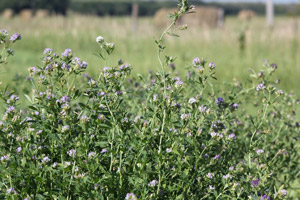Grazing Alfalfa in the Fall
October 2014

Some good pasture still may be available this fall – from your alfalfa fields! But make sure you do it safely with your animals.
Alfalfa can provide considerable, high-quality grazing this fall. Grazing avoids the problem of slow curing of hay that often occurs during the fall and it eliminates the cost of baling.
Many growers find that grazing alfalfa in the fall provides some special flexibility that often is useful this time of year.
- Alfalfa makes an outstanding weaning pasture for spring calves.
- Yearlings gain weight rapidly on fall alfalfa even after summer grass has already died off.
- Cows gain excellent condition before winter by grazing alfalfa during the fall.
- Ewes and lambs perform very well on fall alfalfa.
Fall grazing of alfalfa is not without problems, though. Bloat always must be a concern, but after alfalfa has been frosted and started to dry down it has less tendency to cause bloat than summer alfalfa. Same thing holds true with fully-bloomed-out alfalfa.
To protect your livestock from bloat, fill them with hay before turning them onto alfalfa. Also, maintain access to dry hay or corn stalks while grazing alfalfa to help reduce bloat. Or you can swath your alfalfa ahead of grazing and let animals graze dry hay in the swath. Of course, bloat protectants like poloxalene can be fed as blocks or mixed with grain. This can be an expensive supplement, but it works well when animals eat a uniform amount each day.
Also, be careful not to damage your alfalfa stand. Only graze when fields are dry and firm. Reserve a small sacrifice area to graze and for feeding when soils are wet to avoid damaging the entire field.
If you aren't already doing so, consider alfalfa for late fall pasture. Its advantages greatly exceed any disadvantages.
Bruce Anderson
UNL Forage Specialist